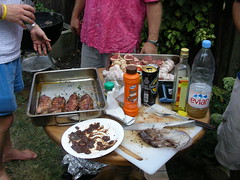 Today, Foursquare launched the ability for anyone to create their own ‘brand’ page on Foursquare. This means that brands or organisations can now quickly set up a presence on the rapidly growing location based network, and share their tips and advice about what to do and where to go.
Today, Foursquare launched the ability for anyone to create their own ‘brand’ page on Foursquare. This means that brands or organisations can now quickly set up a presence on the rapidly growing location based network, and share their tips and advice about what to do and where to go.
Let’s take a quick step back – remember, Foursquare is more than just a game or a tool to announce your location. It’s a social recommendation engine: it lets people find out where their trusted friends and contacts hang out and allows them to share tips and advice about places, from where’s good to eat, to special offers. I wrote a blog post primer on this titled How to win Foursquare friends and influence people.
Why is this new? Until recently, Foursquare had a lengthy and manual process for approving your brand on Foursquare and many organisations nominated an individual to be followed instead who could be their ambassador.
Now, to create a Foursquare brand page, all you need is your brand’s Twitter account, some logos, at least five tips and in about half an hour, you could be up and running and being featured in Foursquare’s page gallery. I had a go this afternoon setting up a page for #smc_mcr in Manchester and came up with some ideas for you to harness the power of Foursquare pages.
Creating a page is a bit like using making a Facebook page. You log in with your own personal Foursquare account and then create the Foursquare brand page. You can then ‘act as’ that Foursquare brand page while setting up the page and leaving tips.
Just one word of warning: if your brand or organisation already has a Twitter account linked to a personal Foursquare account, you won’t be able to create a Foursquare page for it using that Twitter account. If this happens, just un-associate (dissociate!) the brand Twitter account from the existing Foursquare account before you try and create a page.
So, once you’ve got your page set up, what can you use it for? Pages let you do two things: leave tips at locations and ‘check-in’ to a location as a brand. Here’s some ideas for how you can use both:
1. Invite users to your stores or physical location
Foursquare’s all about recommending places, so why not recommend your own? Leave a tip inviting someone to pop in for a cuppa, browse your shop or have a chat. Digital technology often works best when it enables unexpected positive real-world interaction, so make it happen. Even if they don’t take you up on that offer, at least people will remember that there’s a physical location nearby.
It’s even better if you’ve registered any relevant locations and have added “Special Offers”. Also, some cities like Manchester, have a scheme which means that venues can opt-in to allow people to use their toilets for free. This is another idea for a tip and invaluable to know if you need to spend a penny in town!
A note about tips: your tips pop-up on someone’s screen when they check-in nearby, if they’re following you. They also pop-up if they’re not following you, but only if there are no other unread tips from their friends nearby.
Make sure you check-in whenever you visit one of your venues or offices too.
2. Leave tips about things you already like doing
Being on Foursquare is means you’re part of a community of people sharing advice, so get involved. As a brand or organisation, are there fun places that your staff or employees like to hang out? Where do you go for lunch, or a drink after work? Tell Foursquare and tell us why – is it a cheap place to get your daily bread or does it have a great vibe to wind down after a long day in the office?
You could also leave tips relevant to the type of location. For example, is there a really useful information resource that someone should check out?
This is a great way to engage in the general conversation – after all, it’s what most people on Foursquare tend to do. If you have staff parties or outings, then you can check-in to those venues using the Foursquare app. It’s a good way of showing that you represent real people who do ordinary things. And, it’s a great way to spread the love in your local neighbourhood.
3. Holding an event? Let everyone know how to get involved
This is a no-brainer: if you’re having an event that people might be interested in, let them know by dropping a tip at the location. It’s a simple way to promote your event and spread the word to those who might not even know you’re doing something in the area. When the event starts, you can also check-in to the location as a page and tweet that you’re there and it’s going ahead.
This is especially good for community-based events or non-profits, but equally for one-off visits to town by brands like pop-up fashion sales or book-signings. Make sure you add a web link and a Twitter hashtag to your tips and check-ins, so someone can tweet it straightaway.
4. Avoid disparaging tips about competitors (leave that to the punters!)
“My burritos are better than their burritos”. While this may be true, it’s not really the place of a brand or organisation to leave negative comments about the competition. Yes, there are negative tips on Foursquare, but what individual users do is up to them (and will carry far more weight than seeing effectively a self-serving tip.
5. Go global
With Foursquare, your brand or organisation can have a presence way beyond the locality you’re based. Say you’re a non-profit sponsoring projects overseas: leave a tip near there letting local users know how you’ve helped and how they can get involved. If you’re a manufacturing brand or cottage industry, why not leave tips near where you source your raw materials? Or, if you’re a sports team with a global following, let people know where you can meet other fans.
It could be interesting for those local users to know just how far something travels and where it’s used, and it helps raise awareness of your online brand. And of course, if you go travelling or exploring new places, check-in as your brand wherever you go and say what you’ve seen and how it influences your business.
In conclusion, try to make your use of Foursquare relevant, quirky and interesting: plain, irrelevant ad-spam is an instant turn-off and can lead to a negative response on Twitter.
Also, set up your page quickly! Don’t worry if it’s not perfect: I’ve no doubt that we’ll see these pages mushroom, just like they do on Facebook, and it’s best to put something up quicker than it is to wait around to see what happens.
Go ahead and try setting up your brand page now. Do you have any other good ideas for how to use Foursquare pages? Leave a comment below.
 As you can see above, I’ve got a big file taking up quite a large amount of space – though clicking on it shows it’s actually my Mac’s sleep image. The last time I ran this, it showed me a large archive of old emails that I didn’t need anymore too.
As you can see above, I’ve got a big file taking up quite a large amount of space – though clicking on it shows it’s actually my Mac’s sleep image. The last time I ran this, it showed me a large archive of old emails that I didn’t need anymore too.









